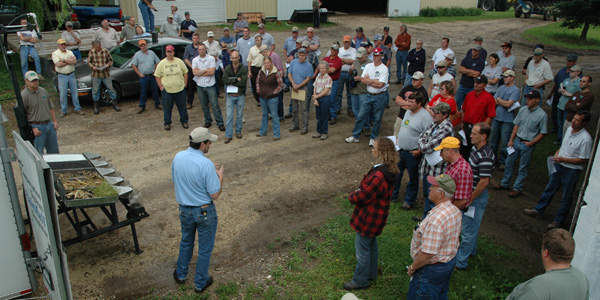
River To River, Water Quality Work Found On Many Fronts
Thomas Isenhart believes Iowa is at a turning point for water quality, a true watershed moment.
“In my 25 years working on water quality in Iowa, I have never seen as much attention to the topic,” Isenhart says. “We have an unprecedented opportunity to reach across all stakeholders to develop and implement practices to improve water quality.”
An associate professor of natural resource ecology and management, Isenhart credits the increased attention on water quality to the Iowa Nutrient Reduction Strategy, which was finalized in May 2013.
Iowa State University was a partner in the strategy’s development, working with the Iowa Department of Agriculture and Land Stewardship (IDALS) and Iowa Department of Natural Resources.
The strategy related to farmland is built on a scientific assessment of practices and associated costs to reduce loading of nitrogen and phosphorus to Iowa surface waters. The College of Agriculture and Life Sciences and IDALS partnered to conduct the assessment.
Isenhart (’83 botany and environmental studies, ’88 MS and ’92 PhD water resources) led the phosphorus portion of the study. “The assessment was an important first step in gathering all the research on agriculture and water quality within Iowa’s corn-soybean systems and comparing how individual or combined practices may reduce downstream nutrient load,” Isenhart says.
Matthew Helmers (’95 civil engineering), associate professor of agricultural and biosystems engineering, led the team that assessed nitrogen issues for the science assessment.
“Our agricultural systems are important in Iowa but evaluating ways we can reduce downstream export of nutrients also is important,” Helmers says. “My interest is seeing agricultural systems implemented that are economically viable and environmentally friendly.”
Applying nitrogen fertilizer in the “right amount and at the right time” is an essential step, but not enough, says Helmers. “The science assessment puts the focus on practices that have the greatest potential for reducing nutrient loss.”
The need to increase voluntary efforts to reduce nutrient loss was one of the key points in the strategy. That led to an implementation phase developed by IDALS —the Iowa Water Quality Initiative.
“The initiative is built on farmers wanting to reduce their environmental impact,” says Bill Northey (’81 agricultural business), Iowa Secretary of Agriculture. In 2013, nearly $3 million in cost-share funds were snapped up by 1,100 farmers and landowners to adopt water quality improvement practices on 120,000 acres.
In December, eight targeted priority watersheds were chosen to receive $4.1 million over the next three years. An additional $8 million in partner and landowner matches were secured. A second round of applications this spring resulted in another five watershed projects that will receive $1.8 million over the next three years and be matched with $2.2 million by partners and landowners.
“These watershed projects play an important role in demonstrating water quality practices and encouraging additional farmer adoption,” Northey says. “There’s a strong commitment among many partners to identify and deploy practices that can make a difference.
Iowa State continues to partner by helping farmers understand what tools and practices best fit their unique land and water situation.
Some of the responsibility for that continued partnership falls to Jamie Benning (’01 agronomy, ’03 MS soil science), who was hired last fall as water quality program manager for ISU Extension and Outreach.
Her duties include expanding water quality programming within extension, increasing connections with partner agencies and organizations and identifying research and extension needs.
“Water quality is an issue that deserves additional attention,” says John Lawrence, associate dean for extension and outreach in the College of Agriculture and Life Sciences and director of ISU Agriculture and Natural Resources Extension and Outreach. “Having Jamie focus on coordinating water quality resources is a great asset.”
“Every Iowa farmer can be part of protecting our water resources,” Benning says. “Many are taking the opportunity to be involved in watershed projects, or reviewing the Iowa Nutrient Reduction Strategy for practices they can implement on their farms.”
Last fall there was a jump in the number of farmers who planted cover crops to slow winter soil erosion and reduce losses of nitrogen and phosphorus. At least 230,000 acres were planted with cover crops in 2013, compared to 65,000 acres in 2012.
Farmer Rob Stout (’78 farm operations) of Washington, Iowa, has seen the success of cover crops first-hand. Farming with his father after graduation, he became interested in no-till planting, learned more at field days and purchased a notill planter in 1983
Besides no-till planting, Stout has built tile-inlet terraces, grassed waterways and buffer strips. He first tried cover crops five years ago.
“It was a combination of me being ready because of heavy spring rains causing erosion even in no-till fields and a program offered through the Iowa Learning Farms and Practical Farmers of Iowa. They wanted farmers to try cover crops in a research environment on 10 acres of strip trials,” Stout says.
He tried it on the 10-acre strips, liked it and increased to 80 acres the next year. Now he’s up to 600 acres of cover crops. “Iowa farmers have a tremendous responsibility to keep our soil and nutrients where they belong and not in creeks and streams that eventually end up in the Gulf of Mexico,” Stout says. “I consider myself a temporary steward of my land.”
During the science assessment, it became clear additional research is needed to address critical gaps in knowledge regarding nitrogen and phosphorus transport. To that end, the Iowa Nutrient Research Center was established at Iowa State in 2013.
The center received $1.5 million from the Iowa Legislature for 2013-2014 and an additional $1.325 million for 2014-2015.
The first set of 10 projects, led by teams of scientists at Iowa State, the University of Iowa and University of Northern Iowa, includes research on bioreactors, cover crops, new technology to more accurately predict movement of nutrients and decision-support tools for farmers.



